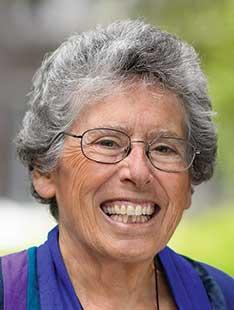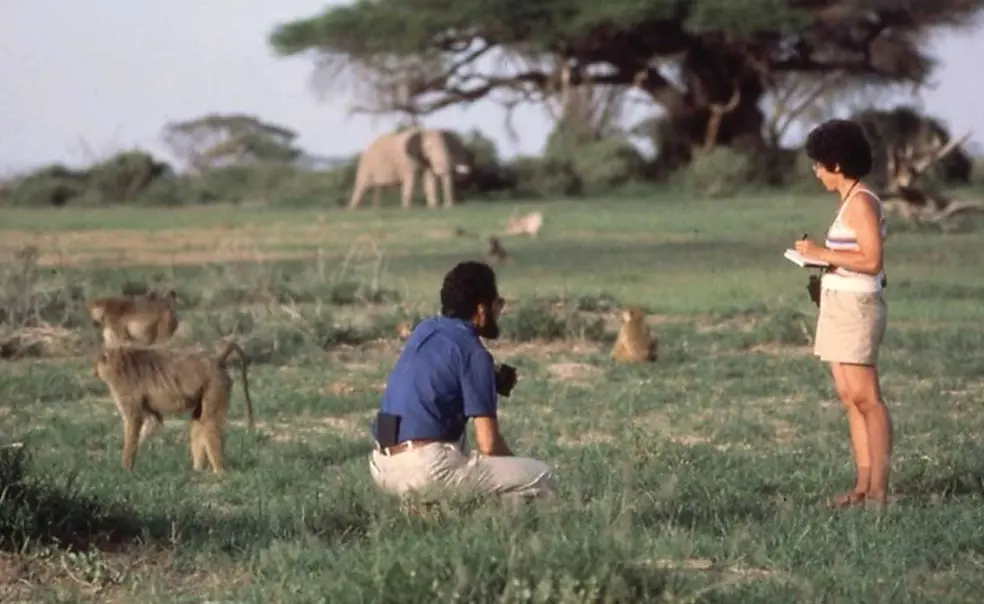Curriculum Vitae: Jeanne Altmann’s ‘Twisty’ Path to Baboon Research
Her perseverance and insight changed the field of biology
In 1957, when Jeanne Altmann was graduating from high school and planning to study math in college, she asked for a slide rule as a graduation present. Her grandmother agreed, but only if one small enough to fit in a ladylike purse could be found. Such mixed messages were pervasive at the time. Altmann’s parents encouraged intellectual conversation and academic success, but “career” was not a word they ever used with their two daughters. At UCLA, in a meeting for roughly 100 incoming math majors, Altmann and the two other women were told by the faculty that assigning them advisers would be “a waste of time.”
Though she followed what she calls a “slow and somewhat twisty path” early on, fitting education into marriage and motherhood, and shifting from math to the study of animal behavior, Altmann was never one to waste time. In her professional journey from that meeting at UCLA to her position as Eugene Higgins Professor Emerita of Ecology and Evolutionary Biology, there were two constants: her determination to satisfy her intellectual yearnings, and, from the early 1960s on, close observation of the baboons of southern Kenya.
She first went to Kenya to help her husband, the late biologist Stuart Altmann. The Amboseli Baboon Research Project, which the couple established in 1971 and which Jeanne has directed ever since, is one of the longest-running field sites in the world. Her rigorous methodology and the decades of discoveries about the evolutionary roots of social behavior that Amboseli has produced have made Altmann one of the leading primatologists of her generation.
Altmann and the two other women math majors were told by the faculty that assigning them advisers would be “a waste of time.”
It was Stuart who introduced her to animal behavior. They met the summer Jeanne was 18 and Stuart was 28. She had a job as a reference librarian at the National Institutes of Health; he came in with a research question. “I went to the zoo with a zoologist,” she wrote to her parents after their first date. They married the next year, and Altmann finished her college education in bursts while following Stuart, first to Boston, where she spent a year at MIT, and then to the University of Alberta, where she received her degree. Her first baby, Michael, was born before she got her bachelor’s degree.
The Altmanns moved to Kenya in 1963 so Stuart could conduct a yearlong study of baboons. In what was then called the Maasai Amboseli Game Reserve, they spent their days sitting on a jury-rigged viewing platform attached to the roof of their Land Rover while 2-year-old Michael played in a makeshift backseat playpen. It proved to be a tumultuous year. Against the backdrop of Kenyan independence, they suffered one medical drama after another: Stuart had pleurisy and an emergency appendectomy; Michael was temporarily paralyzed by a virus.

Her first major contribution made use of her mathematical mind. In the young field of behavioral ecology, there was a fundamental problem with how researchers collected and reported observational data. “You couldn’t tell how most people did it,” Altmann says. The standard “ad lib” approach — noting the behavior one happens to see in a social group — made it difficult to draw valid conclusions. Altmann developed a simple method known as focal sampling, in which observers follow individual animals one at a time in a predetermined fashion, asking the same set of questions for each and recording everything an individual does in a set period of time — eating, grooming, sleeping, fighting, etc. Her 1974 paper on sampling, written before she had even begun her doctoral work, became a model for the field and has more than 16,000 citations.
Soon after that, Altmann embarked on the first research that was truly her own, a yearlong study of baboon motherhood and infancy that won her a dissertation prize in the Department of Human Development at the University of Chicago. Stuart had joined Chicago’s biology department and Jeanne landed in human development in part to avoid joining the same department, and in part because she saw the boundaries between human and animal behavior as permeable.
Her work was unusual because she was studying baboons, not babies, and because she was studying females. “There was this attitude that males were where all the action of evolution was,” she says. “I felt that in mammals, including humans, females potentially had not only ... control over their own lives, to the extent anybody does, but also over the next generation. By the time I finished collecting my data, it was obvious to me that the payoffs came down the road.”
By the early ’80s, Altmann was training Kenyan field assistants and her first graduate students. Stuart’s academic interests had shifted, but Jeanne saw the value of being in it for the long haul (funders took repeated convincing), and Amboseli became her project. Over the years, she has been joined by a like-minded team of scientists and field observers, most of whom have been with the project for decades. Her former student Susan Alberts, an evolutionary anthropologist at Duke, is now lead director of the project, and two of Alberts’ former students, Elizabeth Archie and Jenny Tung, are co-associate directors. “We run it as a family business,” says Archie, a biologist at the University of Notre Dame, who calls herself Altmann’s “academic granddaughter.”
Nearly 50 years on, the Amboseli Baboon Research Project has accumulated consistent data on almost 2,000 animals across seven generations. As technology allowed, Altmann and her colleagues introduced genetic and hormone analysis (they collect a lot of feces). In 1998, she moved from Chicago to Princeton, where she set up an endocrinology lab that allowed the team to expand and make better use of emerging techniques. Although the lab is now under Alberts’ direction at Duke, Altmann is still part of the baboon-project leadership team. With an assistant at Princeton, she maintains part of the project’s database, and she hopes to return to Kenya when pandemic restrictions ease.
Among the group’s many important papers, one of the most famous was a report in 2003 in Science showing that strong social bonds among female baboons led to reproductive success. Another paper the same year showed that baboon fathers helped care for their offspring. More recently, the team demonstrated the cumulative effects of early adversity on the baboons.
At a 2016 event honoring Altmann, Archie said: Her “incredible breadth of experience and willingness to embrace different ideas is one of the main reasons she was able to make such an important impact.” Sometimes, she says, the long road is the right one.
The phrase “Curriculum Vitae” translates to “the course of my life.” In this spirit, PAW is seeking to tell the stories of the lives of Princeton professors emeriti. Please send ideas about other emeriti faculty members whom we might cover to paw@princeton.edu.












No responses yet